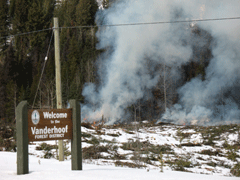
[Editor's note: Colleen Kimmett has been travelling B.C.'s north looking at the changing timber economy there. This is the first of her reports.]
Burn wood waste to make energy. It's a great way to use all that dead beetle wood in B.C., and compared to burning coal, adds far less carbon to the global warming equation. That's what you'll hear from top politicians like Minister of Forests Rich Coleman -- so why isn't B.C. burning up the biofuels track?
A closer look at the industry in this province reveals we are exporting most of our wood fuel pellets to Europe rather than using them to produce energy here. One ambitious attempt to inject millions of bioenergy dollars and hundreds of related jobs into the Prince George area foundered with a key backer complaining about government and First Nations red tape. And all that beetle wood may not be the ideal biofuel after all, when compared to other, dwindling, sources of wood waste.
In other words, the road to bioenergy success in B.C. is a complicated route. And a good place to begin the journey is by sitting down with John Swaan, founder of Pacific BioEnergy Corporation.
Feeding on scraps
Swaan likens the wood pellet producers in British Columbia to the "bottom-feeders" of the forestry industry.
It may not sound like a positive label, especially coming from a man recently hired to boost the wood pellet's profile in Canada.
Yet minutes into our interview over a cup of coffee at a Prince George restaurant, Swaan proudly compares the pellet sector to a lowly crustacean trawling for scraps.
"We add value to what we feed on," he says with a smile. "Like lobsters."
John Swaan founded Pacific BioEnergy in 1994 and is credited with opening up the B.C. pellet market to European buyers. Two years ago he took the role of executive director of the Wood Pellet Association of Canada.
Brothers Rob and Jim own Pinnacle Pellet, with plants in Quesnel and Williams Lake.
Wood pellet producers have existed as a secondary industry in this province for more than two decades, using the wood waste -- sawdust and shavings -- from sawmills.
Thanks to an ample supply of this ideal feedstock, perfect for pellets because it's easily accessible and relatively low in moisture content, the industry has been able to grow despite a small and scattered domestic market for the product.
Today, British Columbia exports more than 900,000 tonnes of pellets per year to Europe. That's one-tenth of the world's supply, more than 75 per cent of Canada's total pellet exports and still only a fraction of what we could be producing.
"There has been little to no competition for the fibre that we basically have been relying on," says Swaan. "There is still one million and a half tonnes of sawmill residue that is finding its way into 23 beehive burners across the province."
Wasted opportunities
According to inventory analyses there is an enormous amount of useable biomass going to waste in the entire forestry industry, not just mills, representing enough energy to meet at least 30 per cent of our current fossil fuel demands.
Bioenergy is now on the provincial government's radar, being touted as a way to help achieve domestic clean energy goals and, better yet, make use of all that mountain pine beetle wood.
Special harvesting licenses guarantee a secure feedstock supply for bioenergy producers, and BC Hydro's February 2008 call for bioenergy guarantees a market for it.
"Energy production is an innovative way to use mountain pine beetle-damaged timber," Forests and Range Minister Rich Coleman said when BC Hydro announced its first call for power.
"It helps to recover the value of the dead wood and creates a viable energy opportunity."
Expensive harvest
However, researchers say beetle-killed wood is just about the least appealing feedstock for bioenergy producers, and now some in forestry and bioenergy are concerned this "great energy opportunity," will only create a bidding war for existing wood waste while hard-to-reach pine stands continue to rot.
"Bioenergy works quite well if you're using residuals from a sawmill," says Brad Stennes, an economist with the Pacific Forestry Centre.
"But if you're going to go out and harvest the beetle killed timber, it's just a costly way to do it."
In 2006 Stennes and researcher Alec McBeath co-authored a report on bionenergy options for trees killed by mountain pine beetle in B.C.
The report estimated it would cost $100 per tonne to produce wood pellets from these dead and dying stands.
This figure was based on a 2003 Swedish study that analyzed the costs of running an industrial pellet plant ($43.94 per tonne converted to 2002 Canadian dollars), plus all of the aggregate costs of harvesting and logging lodgepole pine from the Prince George region ($65.88 per tonne).
"The full costs to access, harvest, transport and return a stand to production completely dissipate the delivered fibre value for energy," concluded the report.
Sifting millions of hectares
Harvesting wood for bioenergy isn't simply a matter of scooping it all up and throwing it in a boiler. Think about collecting firewood. It's wise to be choosy, searching the forest for the dry pieces of wood that are easier to carry and better to burn.
Now, imagine doing this across 9.1 million hectares, the combined area of the Prince George and Quesnel timber supply areas.
In 2004 the Ministry of Forests and Range issued a tender for five beetle-lumber salvage licenses in these areas, permitting an annual allowable cut of 1.25 million cubic meters of timber and requiring the construction or expansion of timber processing facilities that produce something other than dimension softwood lumber.
A North Vancouver engineering firm called C.H. Anderson and Associates partnered with a Stockholm-based biofuel and bioenergy company, TallOil AB, to successfully bid on four of these five licenses, giving them the right to harvest 10.5 million cubic meters of beetle-affected wood over a 10 year period.
In January 2005 the companies announced they would invest $110 million to build four industrial wood pellet plants that would service mostly European thermal power plants, a venture projected to provide 640 jobs in B.C.
False start
Before any work was started, C.H. Anderson bought back its technology and pulled out of the deal.
"From our point of view, we had to go on to other things," said Clay Anderson, the company's president, citing government delays and slow negotiations with First Nations as the main problems that cost the project short-term financing.
Anderson claims his firm found a way around the economic hurdle of harvesting. He wouldn't divulge details of the technology, but says it has to do with accessing "a totally different timber product."
Renewed attempt
In January of this year, Pinnacle Pellet and Pioneer Family Timber Products announced it has purchased the tree harvesting licenses from TallOil, and ground broke two weeks ago on a new pellet plant about 80 kilometres south of Prince George.
Leroy Reitsma, the vice-president of Pinnacle, was tight-lipped about the project, other than to say his approach is different from Anderson's.
"The predecessors were very big on making announcements," says Reitsma. "We're very quietly going about our business."
He did say their plan to deal with the volume will be a combination of pelletization and power production, and says Pinnacle will be getting material from the Dunkley sawmill as well.
As mills close, supply shrinks
Although Dunkley is still pumping out waste to be transformed into pellets, other mills and the people employed by them haven't been so lucky.
In the past year, 34 sawmills in the province have closed permanently or indefinitely, resulting in 10,000 job losses.
Swaan acknowledges that this is a concern for the province's pellet producers.
"We still have a fairly significant surplus of unutilized sawmill residue . . . so it hasn't become a major issue for maintaining the current production capacities that we've got."
"It may have an influence on the new capacities that are being proposed or being considered," he adds.
Jamie Stephen, manager of the bioenergy and biofuel research group at the University of British Columbia, calls competition for feedstock "a very big thing."
"Whoever's using it will go after the low hanging fruit, which is going to be the mill residues, then the slash, then you might start getting into whole tree harvest," says Stephen.
"They [wood pellet producers] are using a waste feedstock," says Stephen, "If suddenly that has a much higher value in terms of electricity, you could use it straight up . . . essentially you might drive some of the pellet producers out of business because there would be massive competition for that feedstock."
Bidding for more bioenergy
BC Hydro's call for bioenergy is being phased in two steps. The first requested proposals for projects that don't require new forest tenure, or permission to harvest, use existing technology and can include mill wood waste, pulp mill residue, roadside residue (slash piles) and standing timber.
The second call, to be issued in July of this year, will be for projects that are not viable right now, technologically or economically.
In an e-mail, BC Hydro spokesperson Susan Danard wrote "BC Hydro has been working on an ongoing basis with government and industry to develop effective contract terms and to mitigate the potential impact of any projects on existing users of wood residual," and added that current bids will be assessed on how they impact existing residual wood users.
"The devil is in the details," says Swaan of how BC Hydro's bioenergy strategy will affect pellet producers. He's optimistic the industry will continue to grow, and that the carbon tax will help make B.C. a user of the fuel instead of just an exporter.
The success of the pellet sector in the province depends on it, says Stephen. In short, we need to think local.
"We're exporting 95 per cent of our production," he says.
"It doesn't make sense for us to export . . . when we could be using it here, essentially accomplishing those goals of clean energy, rural development and energy security."
Next week, Tyee reporter Colleen Kimmett examines the question of how to manage forests so wood producers and energy producers can benefit.
Related Tyee stories:
- Pine Beetle, Mr. Opportunity?
The bug brings floods, fires and talk of new economies. - Forestry Firms Burning Jobs
Why they'd rather torch timber than feed mills. - Selling Doomsday Debits
In BC's wasteful forest biz, carbon credits don't grow on trees.
Read more: Labour + Industry, Science + Tech, Environment















Tyee Commenting Guidelines
Comments that violate guidelines risk being deleted, and violations may result in a temporary or permanent user ban. Maintain the spirit of good conversation to stay in the discussion.
*Please note The Tyee is not a forum for spreading misinformation about COVID-19, denying its existence or minimizing its risk to public health.
Do:
Do not: